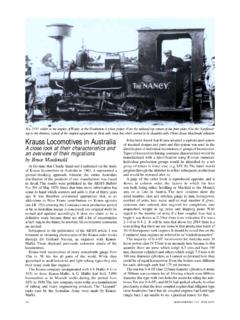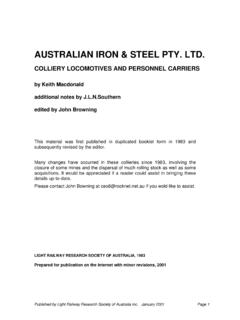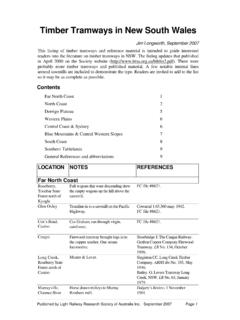Transcription of Fyansford Cement Works Railway
1 LIGHT railways 222 DECEMBER 20113 Fyansford Cement Works Railway Recalled in photographsby Richard HorneThe 45th anniversary of the closure of a unique Victorian industrial Railway will be celebrated on 22 December 2011. This was the 3ft 6in gauge system of the Australian Portland Cement Company Ltd (APC) at its Fyansford Cement Works , where steam was used to the very end. Located just over two miles to the west of central Geelong, it was easily accessible to enthusiasts, even without a car, and visitors were invariably made welcome. The operation was akin to that of a miniature main line, running from the quarry at Batesford, some 3 miles to the north-west, to a balloon loop with wagon tippler at the Works . The locomotive roster ranged from diminutive 0-4-2 STs built in the Edwardian era, to a mighty war-time Australian Standard Garratt, supplemented in 1956 by a Bo-Bo Diesel Electric, of the same design as the Victorian railways T Railway was described in detail by John McNeill in LR 120 (April 1993) but a brief history is given here, to supplement this photographic essay.
2 The APC commenced quarrying limestone in 1890, transporting it to the Works in horse-drawn wagons. In 1905 a horse-drawn tramway was built, covering part of the journey, but in 1911 an aerial ropeway was opened between the quarry and the Works . The Victorian railways (VR) opened a branch to the Works in 1918, for the inwards shipment of coal and despatch of Cement . From 1921 to 1925 the Works were modernised and in 1924 the aerial ropeway was abandoned, the quarry then being connected to the Works by a 3ft 6in gauge Railway . The line crossed the Moorabool River twice on timber trestle bridges and used a fleet of four Hudswell Clarke 0-4-2ST locomotives, purchased second-hand from the Wallaroo & Moonta Mining & Smelting Co Ltd, which had closed its copper mines in South Australia the previous year.
3 They retained their original owner s numbers of 6, 7, 8 and 9 and were supplemented in 1926 by two Vulcan Iron Works 0-6-0 STs, numbered 3 and 4, that had been used at the Henderson Naval Base in Western 1931 operations were transferred to a new quarry, to the south of the original one, worked on the glory hole principle, with a floor level about 120 feet below ground level. The new line climbed out of this quarry through a curving tunnel over mile long and on a 1 in 37 grade. Part of the old line, beyond the point where the new line joined, but short of the northern-most bridge over the Moorabool, was retained for storage and servicing the steam shovels down in the quarry. As traffic increased, a 2-6-0+0-6-2 Garratt locomotive was purchased in 1936, followed by a second in 1939, both being similar in design to the WAGR Ms class.
4 They were numbered 1 and 2. Unused Australian Standard Garratt locomotive No. G-33, which had been erected at the VR Newport Works , was purchased in 1946 and numbered 3. In the same year, two small 0-4-0Ts built by Perry Engineering were purchased third-hand from the State Electricity Commission of Victoria at Yallourn and numbered 10 and 11. They were followed in 1956 by the Railway s last locomotive and sole diesel. Built by Clyde/GM, it was numbered D1 and named WESLEY B other rail vehicles used at the Works are worthy of mention. One of the shovels used at the quarry working face was a rail-mounted Bucyrus Model 65C steam shovel built in 1903, but second-hand to Fyansford c1923 from the Mount Morgan Gold Mining Company Ltd in Queensland.
5 During an Association of Railway Enthusiasts (ARE) tour on 10 September 1966, Garratt moves off with the improvised tour train , while locomotives 6, 11 and 4 look on from outside the engine shed. Photo: Richard Warren, collection Richard HorneLIGHT railways 222 DECEMBER 20114 Above: The original locomotive fleet at Fyansford consisted of four Hudswell Clarke 0-4-2ST locomotives, purchased second-hand from the Wallaroo & Moonta Mining & Smelting Co. Ltd, in South Australia. Around 1930, number 7 (Hudswell Clarke 774 of 1906) sits outside the original engine shed. Photo: Collection Eric Bowes Below: Fyansford s final steam acquisition was this impressive 4-8-2+2-8-4 Australian Standard Garratt (VR Newport 1945), seen here on the loop at the Works on 10 June 1966.
6 Photo: Richard Warren, collection Richard HorneLIGHT railways 222 DECEMBER 20115 Above: With a happy group of railfans trailing behind, crosses Moorabool Bridge, on 10 September 1966. Photo: Richard Warren, collection Richard Horne Right: Number 6 on a workers train, 9 January 1964. Photo: Richard Warren, collection Richard HorneBelow: Vulcan 0-6-0ST number 4 at work in the Batesford Quarry, 27 February 1966. Photo: Richard Warren, collection Richard HorneLIGHT railways 222 DECEMBER 20116 Above: Number 6 (at right) a four-wheel steam Railway grab crane, built by Ruston & Hornsby, has tracked Ruston number 3 for company in its retirement. 12 January 1965. Photo: Richard HorneRight: Bucyrus steam shovel number 2, built in 1903, spent its final years powered by compressed air.
7 12 January 1965. Photo: Richard HorneBelow: On a wet, miserable 2 March 1964, four little engines in a row (from left, 10, 7, 9 and 8) rust away on a siding at the Works . Photo: Richard Horne LIGHT railways 222 DECEMBER 20117It was last in steam in 1951, but latterly used as a crane with a lift of 20 tons, running on compressed air. Trans-shipment of coal in the VR exchange sidings was carried out by a 5ft 3in gauge four-wheel steam Railway grab crane, numbered 6, and built c1924 by Ruston & Hornsby, being Ruston Crane Navvy No. No. 2 was rebuilt using the boiler from , the remainder of which was ultimately scrapped. Locomotives 7, 8, 9 and 10 were set aside and eventually scrapped in 1964. In 1966 the Railway was replaced by a limestone conveyor from the quarry to the Works and the Association of Railway Enthusiasts made a farewell visit on 10 September, for which locos 2, 3, 4, 5, 6 and 11 were in steam, with D1 hauled out of the loco shed.
8 Trips over the line, short of the tunnel, were provided for the visitors, riding in the limestone wagons. Failure of the conveyor on 10 and 11 October saw 4 and D1 back in use, while the very last steam operation, using number 6, was made on 22 December 1966. After that, D1 was used for a period on weekly inspections of the line, but the track was removed in 1968, by Dickson Primer. Fortunately, all of the steam locomotives present at closure have been preserved and a number of them are currently in use. +DLQHV 5 HVHUYH012 Kms3 Moorabool RiverQuarryTunnelFyansfordc1960 NMMcC 09/11 GeelongCement WorksGeelongRingRoadLIGHT railways 222 DECEMBER 20118 Above: No. 1 s safety valves lift as it Works hard hauling a loaded train towards to Works in October 1943.
9 Photo: JB GoggsRight: A visitors pass to the Works . Apparently useful for taking photographs of the Railway action, but not valid to ride on locos . Below: Clyde/GM diesel locomotive D1 joined the fleet in 1956. On 10 September, 1966, the ARE farewell tour, it was hauled out of the loco shed by Vulcan 0-6-0ST number 5. Photo: Richard Warren, collection Richard HorneLIGHT railways 222 DECEMBER 20119 Above: D1 and number 4 meet up inside the quarry on 27 January 1966. Photo: Richard Warren, collection Richard HorneBelow: Perry 0-4-0T number 11 (267 of 1926) and Hudswell Clarke 0-4-2ST number 6 (646 of 1903) were both in steam sitting outside the loco shed at the Works on 10 September 1966, when an ARE tour was run and six locomotives were in steam for the occasion.
10 Photo: Richard Warren, collection Richard HorneLIGHT railways 222 DECEMBER 2011102 and 11 went to the Puffing Billy Railway Preservation Society s museum at Menzies Creek, but in 2009 they were transferred to the Bellarine Railway . There they joined 4, 5 and 6. 4 and 6 had come via the Belmont Common Railway and No. 5 via a period in a park in Ringwood. ASG number 3 is now on static display at the ARHS Williamstown Railway Museum. D1 was sold to the Victorian railways becoming, following modifications, T413. It was towed away from Fyansford (presumably on accommodation bogies) by sister locomotive T336 on 24 May 1969. The Bucyrus steam shovel is now preserved at Lake Goldsmith in Victoria and was steamed (using a temporary boiler) in February Cement Works , under the ownership of Adelaide Brighton Cement , were closed in 2001.








